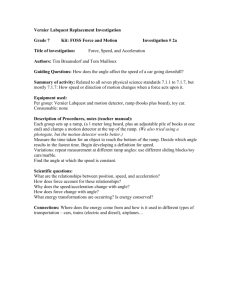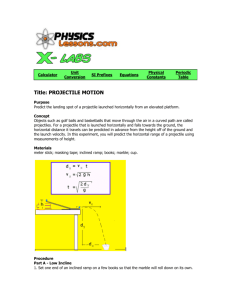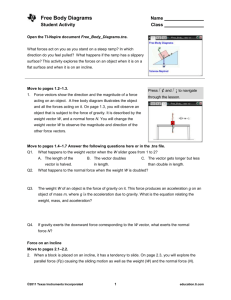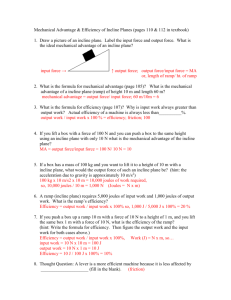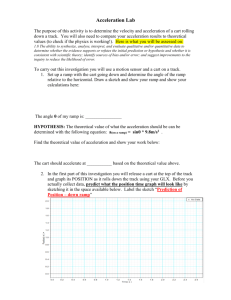Uniform & Accelerated Motion Lab: Procedure & Analysis
advertisement
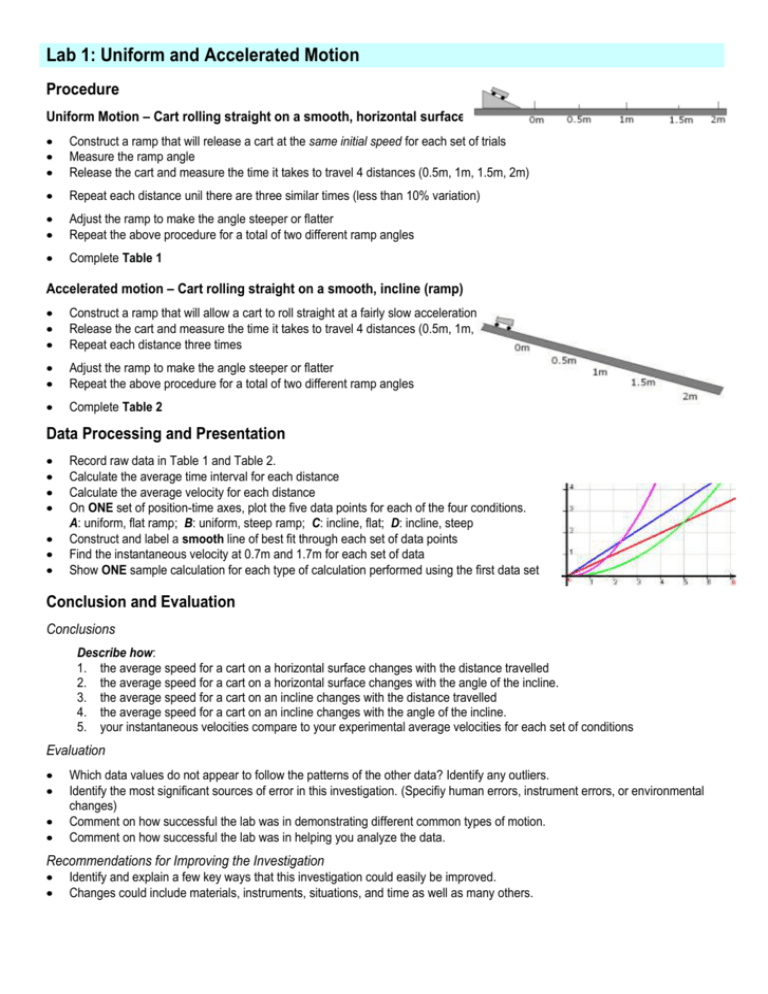
Lab 1: Uniform and Accelerated Motion Procedure Uniform Motion – Cart rolling straight on a smooth, horizontal surface Construct a ramp that will release a cart at the same initial speed for each set of trials Measure the ramp angle Release the cart and measure the time it takes to travel 4 distances (0.5m, 1m, 1.5m, 2m) Repeat each distance unil there are three similar times (less than 10% variation) Adjust the ramp to make the angle steeper or flatter Repeat the above procedure for a total of two different ramp angles Complete Table 1 Accelerated motion – Cart rolling straight on a smooth, incline (ramp) Construct a ramp that will allow a cart to roll straight at a fairly slow acceleration Release the cart and measure the time it takes to travel 4 distances (0.5m, 1m, 1.5m, 2m) Repeat each distance three times Adjust the ramp to make the angle steeper or flatter Repeat the above procedure for a total of two different ramp angles Complete Table 2 Data Processing and Presentation Record raw data in Table 1 and Table 2. Calculate the average time interval for each distance Calculate the average velocity for each distance On ONE set of position-time axes, plot the five data points for each of the four conditions. A: uniform, flat ramp; B: uniform, steep ramp; C: incline, flat; D: incline, steep Construct and label a smooth line of best fit through each set of data points Find the instantaneous velocity at 0.7m and 1.7m for each set of data Show ONE sample calculation for each type of calculation performed using the first data set Conclusion and Evaluation Conclusions Describe how: 1. the average speed for a cart on a horizontal surface changes with the distance travelled 2. the average speed for a cart on a horizontal surface changes with the angle of the incline. 3. the average speed for a cart on an incline changes with the distance travelled 4. the average speed for a cart on an incline changes with the angle of the incline. 5. your instantaneous velocities compare to your experimental average velocities for each set of conditions Evaluation Which data values do not appear to follow the patterns of the other data? Identify any outliers. Identify the most significant sources of error in this investigation. (Specifiy human errors, instrument errors, or environmental changes) Comment on how successful the lab was in demonstrating different common types of motion. Comment on how successful the lab was in helping you analyze the data. Recommendations for Improving the Investigation Identify and explain a few key ways that this investigation could easily be improved. Changes could include materials, instruments, situations, and time as well as many others. Table 1. Uniform Motion – Cart rolling straight on a smooth, horizontal surface after being launched from a flat or steep ramp. Distance (m) Trial Time (s) 0 1 2 3 Average 1 2 3 Average 1 2 3 Average 1 2 3 Average 0 Flatter Ramp (angle = °) 0.5000 1.0000 1.5000 2.0000 Velocity (m/s) Ramp Incline Distance (m) Trial Time (s) 0 1 2 3 Average 1 2 3 Average 1 2 3 Average 1 2 3 Average 0 0.5000 Steeper Ramp (angle = °) Ramp Incline 1.0000 1.5000 2.0000 Velocity (m/s) Table 2. Accelerated Motion – Cart rolling straight on a smooth, inclined surface (either flatter or steeper) after being launched from rest. Distance (m) Trial Time (s) 0 1 2 3 Average 1 2 3 Average 1 2 3 Average 1 2 3 Average 0 Flatter Surface (angle = °) 0.5000 1.0000 1.5000 2.0000 Velocity (m/s) Surface Incline Distance (m) Trial Time (s) 0 1 2 3 Average 1 2 3 Average 1 2 3 Average 1 2 3 Average 0 0.5000 Steeper Surface (angle = °) Surface Incline 1.0000 1.5000 2.0000 Velocity (m/s)



